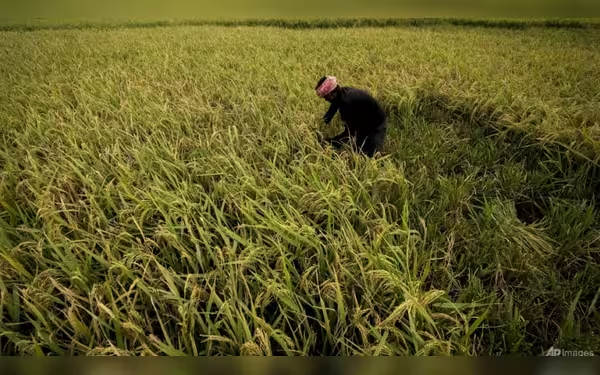Thursday, November 21, 2024 06:28 AM
India Develops Climate-Resilient Crops Amid Rising Heatwaves
- India focuses on climate-resilient crops to combat food insecurity.
- Government unveils 109 new high-yield crop varieties.
- Private companies support advanced farming technologies.
 Image Credits: channelnewsasia
Image Credits: channelnewsasiaIndia is developing climate-resilient crops to address food security challenges posed by climate change and rising heatwaves.
As the world grapples with the pressing challenges posed by climate change, India, the second-largest producer of rice and wheat, is taking significant steps to adapt its agricultural practices. With a population of 1.4 billion people relying heavily on these staple grains, the impact of climate change is becoming increasingly evident. More frequent heatwaves and water crises threaten food security, prompting the Indian government to explore innovative solutions.
In response to these challenges, India is now focusing on developing climate-resilient crops. These new varieties are designed to withstand extreme weather conditions, such as droughts and cyclones. According to Apoorve Khandelwal, a senior programme lead at the Council on Energy, Environment and Water, these crops feature “thicker leaves” and a “better physiological structure,” enabling them to endure harsh climates. The urgency of this initiative is underscored by government estimates that climate change could reduce yields for rainfed rice and wheat by approximately 20% by 2050, escalating to 40% by 2080.
In a recent event, Indian Prime Minister Narendra Modi unveiled 109 high-yield, climate-resilient, and nutritionally dense varieties of 61 crops. These include pulses, oilseeds, and various horticultural products such as fruits and vegetables. Since 2014, the government has developed nearly 1,900 such varieties, aiming to distribute them to farmers across the country. However, convincing farmers to transition from traditional crops to these new varieties remains a significant challenge.
While the initiative holds promise, it comes with financial implications. India is allocating a substantial US$32 billion to the agriculture sector, but a large portion of this budget is designated for welfare measures and subsidies. The amount allocated for crop research and development is relatively small, raising concerns among experts. Khandelwal pointed out that the spending on climate-resilient agriculture practices is “miniscule” compared to subsidies, highlighting a disparity that could hinder progress.
In addition to government efforts, private companies like Bayer are stepping in to support climate-resilient farming. Bayer is collaborating with an Indian government agency to implement advanced technologies, such as drones for crop monitoring and pesticide spraying. They are also promoting the use of direct seeding rice machines, which can significantly reduce water usage and greenhouse gas emissions.
As India prepares for an uncertain climate future, the hope is that these public-private partnerships will enhance the resilience of the agricultural sector. By investing in innovative practices and technologies, there is potential not only to safeguard the livelihoods of farmers but also to ensure food security for billions of people worldwide. The journey towards climate-resilient agriculture is not just a necessity; it is a vital step towards a sustainable future.













